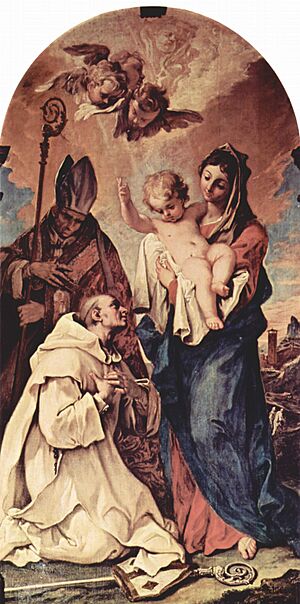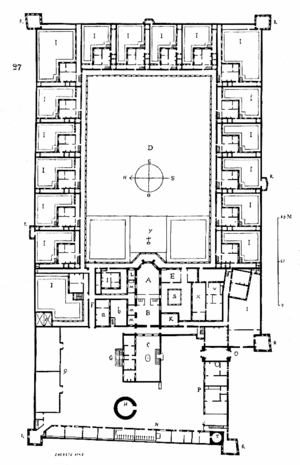Carthusians facts for kids
|
Ordo Cartusiensis
|
|
 |
|
| Formation | 15 August 1084 |
|---|---|
| Founder | Bruno of Cologne |
| Founded at | France |
| Type | Monastic Order of Pontifical Right (for Men) |
| Headquarters | Grande Chartreuse (Mother House) |
|
Membership
|
About 380 |
| O.Cart. | |

The Carthusians are a special group of Catholic monks and nuns. They are also known as the Order of Carthusians (Latin: Ordo Cartusiensis). This order was started by Bruno of Cologne in 1084.
Carthusians live a very quiet life, combining time alone (like a hermit) with some community activities. Their motto is Stat crux dum volvitur orbis, which means 'The Cross is steady while the world turns'. They also have their own special way of worship, called the Carthusian Rite.
The name Carthusian comes from the Chartreuse Mountains in France. Bruno built his first home there. The word charterhouse is the English name for a Carthusian monastery. Today, there are 23 charterhouses around the world. Most are for monks, and some are for nuns.
Contents
History
In 1084, a bishop named Hugh of Grenoble offered Bruno a quiet place in the mountains. Bruno and six friends built a small home there. It had wooden cabins and a covered walkway to a church and dining room. This helped them stay out of bad weather.
Six years later, Bruno's old student, Pope Urban II, asked for his help. Bruno moved to Rome for a short time. Then he started a new quiet home in Italy. He passed away there in 1101.
In 1132, a big snowslide destroyed the first home. Seven monks died. The fifth leader of the Carthusians, Guiges, rebuilt it.
Carthusians in Britain
Before the Reformation, there were ten Carthusian monasteries in Britain. One was in Scotland and nine were in England. The first was started in 1181 by Henry II of England. He did this as a way to make up for the death of Thomas Becket.
During the Reformation, the Carthusians, like other Catholic groups, faced difficulties. Many of their monasteries were closed down. Later, the French Revolution also caused problems for them in France.
Today, you can still see parts of old charterhouses. The Charterhouse, Coventry was opened to the public in 2023. It has old wall paintings and carvings. The best preserved old charterhouse in the UK is Mount Grace Priory in North Yorkshire. You can see how a monk's cell was set up there.
The London Charterhouse gave its name to Charterhouse Square and the Charterhouse School. The school used to be on the monastery's land.
In Scotland, the only Carthusian monastery was Perth Charterhouse. It was built in the early 1400s by King James I. Important people like James I and his wife were buried there. The monastery was destroyed in 1559. Now, only a monument marks the spot.
There is still an active Carthusian monastery in England. It is called St Hugh's Charterhouse, Parkminster in West Sussex. It has a very large cloister, which is a covered walkway around a courtyard.
Life in a Charterhouse
A Carthusian monastery is usually small. It has many individual cells built around a cloister. Each cell's door opens onto a long hallway.
The main goal of Carthusian life is quiet thinking and prayer. So, being alone and silent is very important. Carthusians do not have abbots. Instead, each charterhouse has a leader called a prior. There are two types of monks: choir monks (also called hermits) and lay brothers. Choir monks focus more on prayer, while lay brothers help with daily tasks.
Musical practice
Carthusians do not use musical instruments in their worship. This is similar to some old traditions.
Choir Monks
Each choir monk, who is or will be a priest, has his own living space called a cell. It usually has two floors. The bottom floor is for storing wood and for a workshop. Monks do some manual work. The top floor has a small entrance with a picture of the Virgin Mary. It also has a larger room with a bed, a table for meals, a desk for studying, and a place for prayer.
Each cell has a garden with high walls. Here, the monk can meditate or grow flowers or vegetables for the community.
Next to the door of each cell is a small turning box called a "turn." This allows meals and other items to be passed in and out without the monk seeing the person delivering them. Most meals are given this way. The monk eats alone in his cell. Carthusians never eat meat.
A monk spends most of his day in his cell. He meditates, prays, eats, studies, writes, and works in his garden. He leaves his cell only for three prayer services in the chapel each day, including community Mass. Once a week, the monks take a long walk together in the countryside. During this walk, they are allowed to speak. On Sundays and special feast days, they eat a meal together in silence.
Lay Brothers
Lay brothers have always been part of the charterhouse. They also live a life of quiet prayer and join in community prayers and Mass. However, lay brothers spend more time doing manual work. They help the choir monks by cooking, doing laundry, making repairs, and managing supplies. Their work helps the choir monks live their secluded lives.
During their training, lay brothers study the Bible, theology, and spirituality. All monks, both choir monks and lay brothers, live very quiet lives.
Carthusians do not do missionary work or host retreats for many visitors. They have very little contact with the outside world.
Carthusian nuns live a life similar to the monks. They also focus on solitude and silence, but their daily life might be a little less isolated.
Modern Carthusians
Today, the Grande Chartreuse in France is still the main monastery of the order. There is a museum nearby that shows the history of the Carthusians. The monks at Grande Chartreuse also help make Chartreuse liqueur. You cannot visit the monastery itself. However, a 2005 movie called Into Great Silence showed what life is like inside.
Carthusians today live much as they always have, following their rules strictly. People who want to join must usually be between 21 and 45 years old. They also need medical checks. New members learn about Lectio divina, which is spiritual reading.
In the 21st century, one charterhouse in France, Sélignac, was changed. Now, other people can visit there for short retreats. They can experience the quiet Carthusian way of life for a few days.
Liturgy
Before the 1500s, the Catholic Church had many different ways to celebrate Mass. While the main parts were the same, prayers and practices varied.
When Pope Pius V made the Roman Missal standard for all Catholics, he allowed older forms of Mass to continue if they had been used for at least 200 years. The Carthusians' way of worship was one of these. They still use a version of it today, updated in 1981. It is mostly the same as it was in the 1100s.
A special Carthusian practice is that nuns receive a stole and a maniple when they make their vows. These are special cloths worn by priests. The nun wears them again only on her monastic jubilee (a special anniversary) and after her death. If no priest is present, a nun can read the Gospel during morning prayers while wearing the stole.
Formation
Becoming a Carthusian starts with 6 to 12 months as a postulant. Then, there are two years as a novice. During this time, the novice wears a black cloak over the white Carthusian habit. After that, the novice takes simple vows for three years and wears the full Carthusian habit. These simple vows can be renewed for another two years. Finally, the Carthusian makes their solemn (final) vows.
Locations of monasteries
As of March 2024, there are 21 active charterhouses. Sixteen are for monks and five are for nuns. They are located in many countries, including France, Italy, Spain, the United Kingdom, and the United States.
Notable Carthusians
- Bruno of Cologne (around 1030–1101) - The founder of the order.
- Guigo I (1083–1136) - The fifth prior who rebuilt the monastery after an avalanche.
- Hugh of Lincoln (1135/40-1200) - An important Carthusian leader.
- Denis the Carthusian (1402–1471) - A famous writer and thinker.
See also
 In Spanish: Orden de los Cartujos para niños
In Spanish: Orden de los Cartujos para niños
- Into Great Silence - A documentary about Carthusian life.
- List of Carthusian monasteries
- Carthusian Martyrs - Carthusians who died for their faith.
- Spatiamentum - The weekly walk taken by Carthusian monks.





